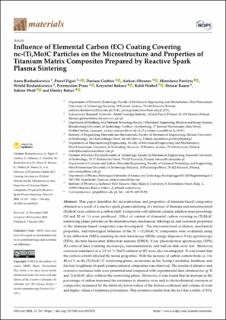| dc.description.abstract | This paper describes the microstructure and properties of titanium-based composites obtained as a result of a reactive spark plasma sintering of a mixture of titanium and nanostructured (Ti,Mo)C-type carbide in a carbon shell. Composites with different ceramic addition mass percentage (10 and 20 wt %) were produced. Effect of content of elemental carbon covering nc-(Ti,Mo)C reinforcing phase particles on the microstructure, mechanical, tribological, and corrosion properties of the titanium-based composites was investigated. The microstructural evolution, mechanical properties, and tribological behavior of the Ti + (Ti,Mo)C/C composites were evaluated using X-ray diffraction (XRD), scanning electron microscopy (SEM), energy dispersive X-ray spectroscopy (EDX), electron backscatter diffraction analysis (EBSD), X-ray photoelectron spectroscopy (XPS), 3D confocal laser scanning microscopy, nanoindentation, and ball-on-disk wear test. Moreover, corrosion resistance in a 3.5 wt % NaCl solution at RT were also investigated. It was found that the carbon content affected the tested properties. With the increase of carbon content from ca. 3 to 40 wt % in the (Ti,Mo)C/C reinforcing phase, an increase in the Young’s modulus, hardness, and fracture toughness of spark plasma sintered composites was observed. The results of abrasive and corrosive resistance tests were presented and compared with experimental data obtained for cp-Ti and Ti-6Al-4V alloy without the reinforcing phase. Moreover, it was found that an increase in the percentage of carbon increased the resistance to abrasive wear and to electrochemical corrosion of composites, measured by the relatively lower values of the friction coefficient and volume of wear and higher values of resistance polarization. This resistance results from the fact that a stable of TiO2 layer doped with MoO3 is formed on the surface of the composites. The results of experimental studies on the composites were compared with those obtained for cp-Ti and Ti-6Al-4V alloy without the reinforcing phase | en_US |

